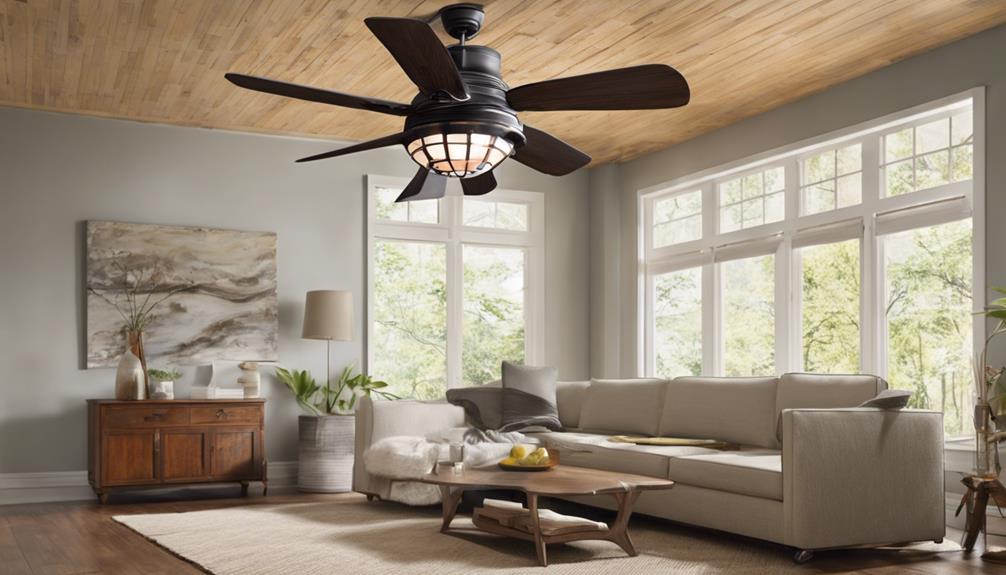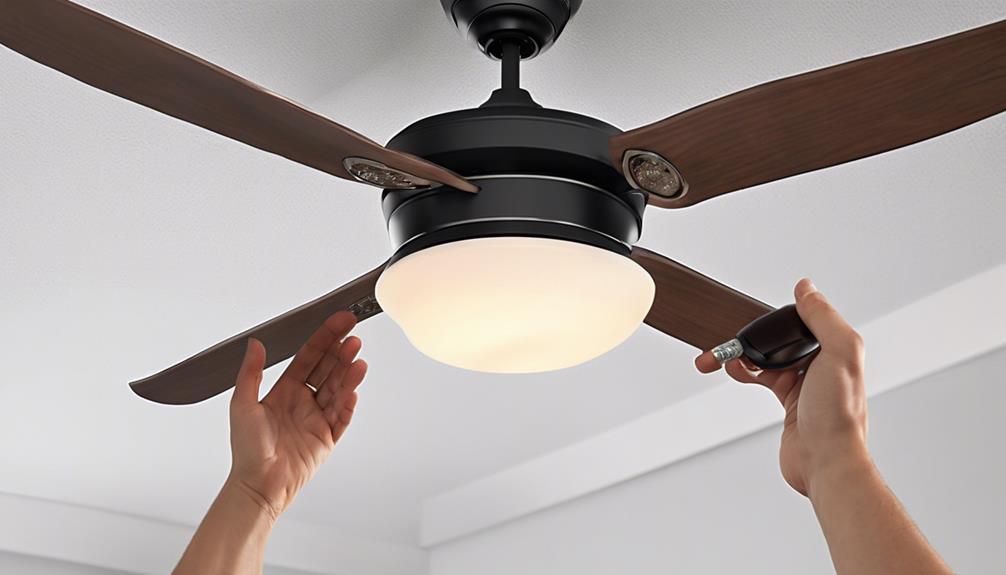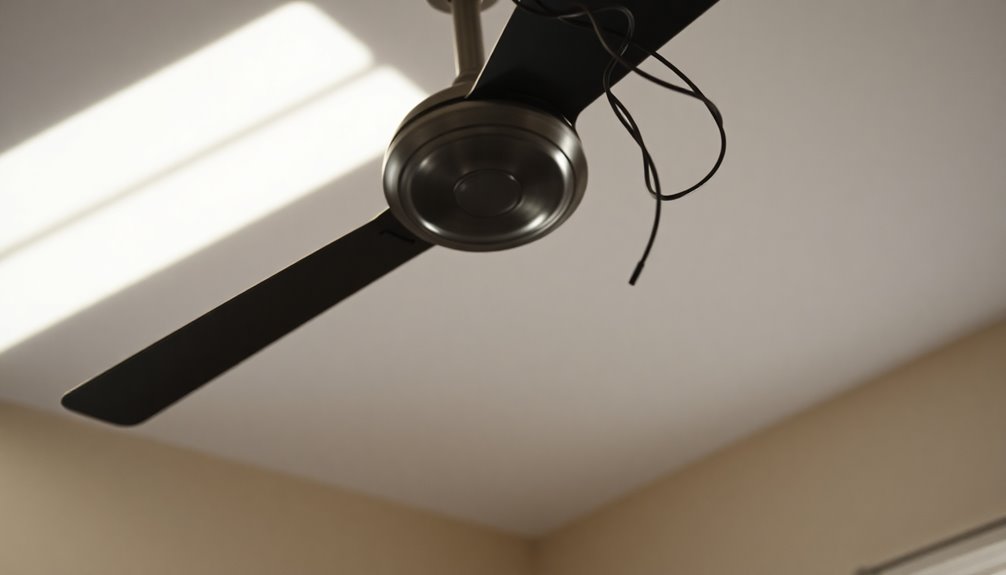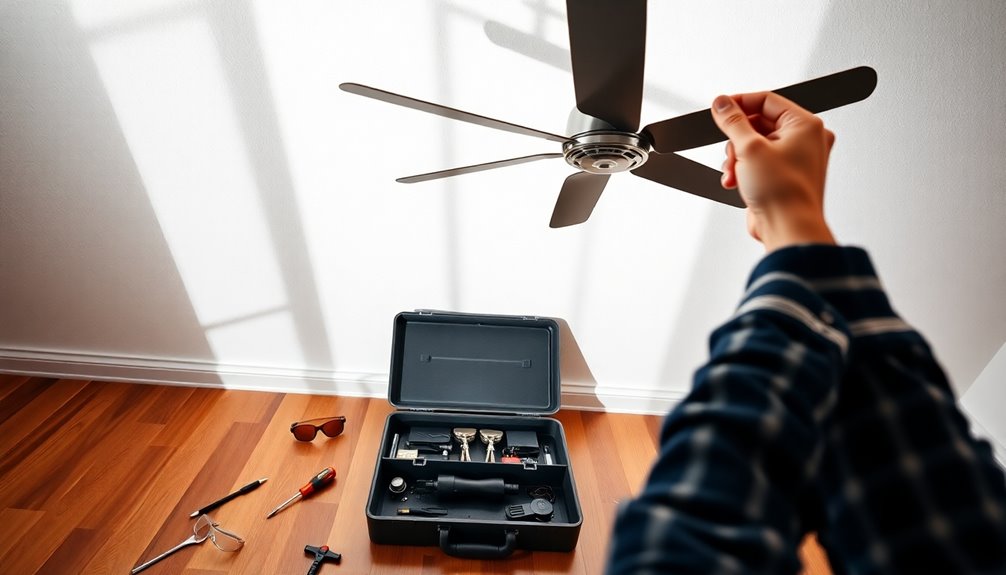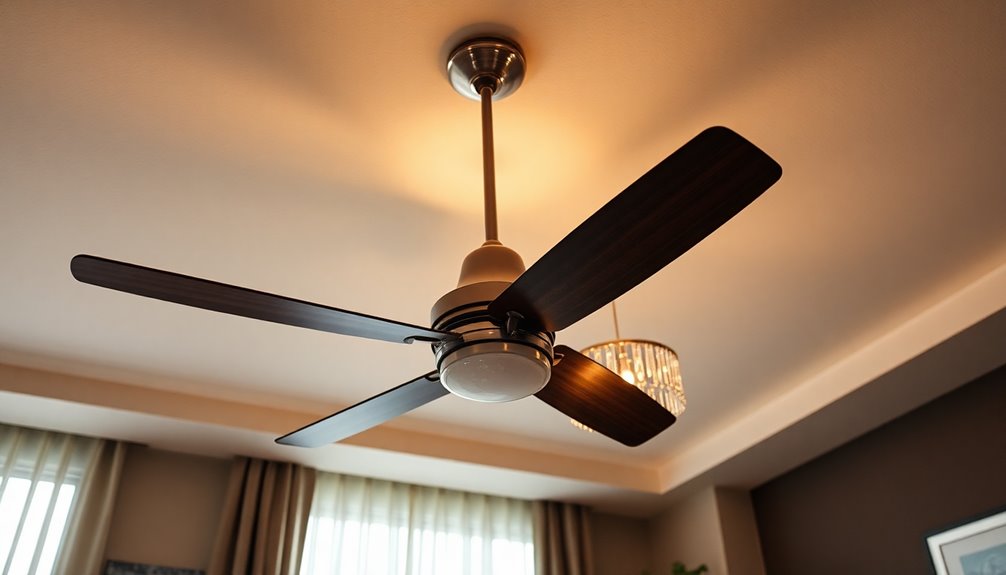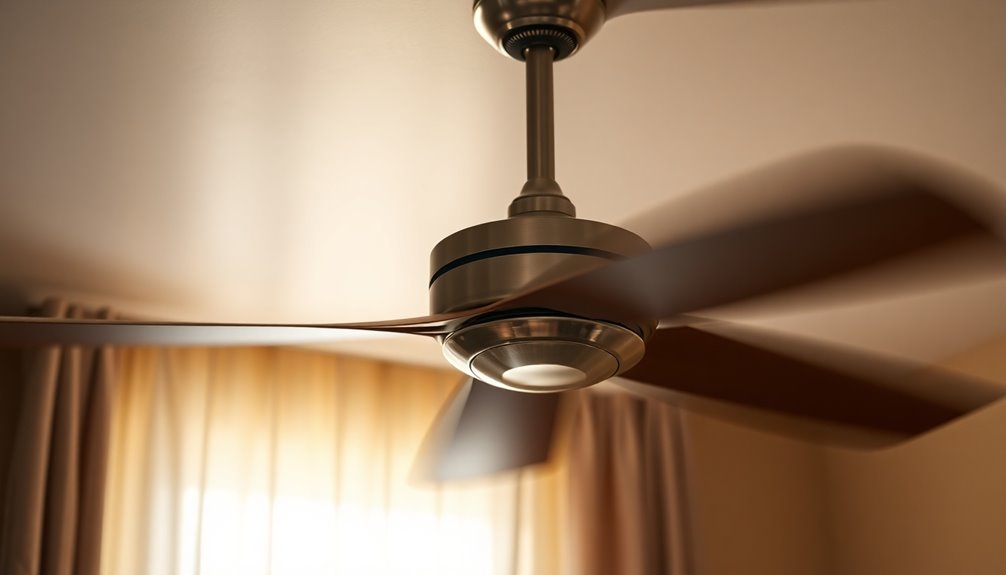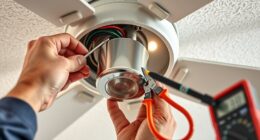Mastering the direction of your ceiling fan is crucial for ultimate comfort. In summer, set it to spin counterclockwise for a cooling breeze, reducing energy costs. For winter warmth, switch it to clockwise to circulate heat efficiently, cutting utility bills. Regularly adjusting its direction based on the season can save up to 30% on energy costs annually. For a personalized approach, consider smart home options that adjust fan settings automatically. These simple changes can enhance comfort and reduce energy consumption effectively. By optimizing your ceiling fan direction, you can create a more comfortable living environment while saving on utility expenses.
Key Takeaways
- Adjust fan counterclockwise in summer for a cooling breeze.
- Switch fan clockwise in winter to distribute warmth efficiently.
- Use high speed for a wind chill effect in warm months.
- Enhance comfort and save energy by optimizing fan direction.
- Maximize fan efficiency for year-round comfort and cost savings.
Importance of Ceiling Fan Direction
Understanding the significance of ceiling fan direction is crucial for maximizing comfort and energy efficiency in your living space. Proper ceiling fan direction plays a key role in promoting optimal air circulation, which can have a significant impact on the temperature and overall atmosphere of a room.
By setting your ceiling fan to rotate in the correct direction, you can enhance the effectiveness of your heating system during winter by pushing warm air down and redistributing it throughout the room. In the summer months, ensuring that your fan rotates counterclockwise creates a cooling downdraft that enhances comfort by creating a breeze effect.
Benefits of Counterclockwise Rotation

Counterclockwise rotation of ceiling fans during the summer provides a refreshing downdraft that enhances comfort levels. This direction helps to maintain a consistent temperature, reducing the need for excessive air conditioning usage and saving on energy costs.
Additionally, the wind chill effect created by counterclockwise rotation at higher speeds can offer additional cooling benefits.
Cooling Airflow Distribution
When the ceiling fan rotates counterclockwise, it efficiently distributes cool airflow throughout the room, enhancing comfort during hot summer months. This direction creates a cooling downdraft, promoting a refreshing breeze and maintaining a consistent room temperature. By running the fan counterclockwise at high speed, a pleasant wind chill effect is achieved, allowing for a higher thermostat setting without sacrificing comfort. This optimization in airflow distribution not only enhances cooling efficiency but also reduces energy costs by up to 30%. Choosing the correct fan direction, such as counterclockwise in summer, maximizes air circulation, creating a more comfortable environment for all.
| Benefits of Counterclockwise Rotation |
|---|
| Enhanced comfort during summer |
| Wind chill effect at high speed |
| Reduced energy costs by up to 30% |
| Consistent room temperature |
Energy Efficiency Boost
To maximize energy efficiency, spinning your ceiling fan counterclockwise in warmer months can significantly reduce cooling costs while maintaining a comfortable environment. This simple adjustment offers several benefits:
- Counterclockwise rotation in summer creates a cooling downdraft, enhancing comfort.
- Running the fan counterclockwise allows for a wind chill effect, reducing the need for lower thermostat settings.
- Adjusting the fan direction can save up to 30% on energy costs during warmer months.
- Ceiling fans set to spin counterclockwise help maintain a comfortable temperature without over-relying on air conditioning.
- Pairing counterclockwise rotation with air conditioning can maximize energy efficiency and cooling benefits.
Advantages of Clockwise Rotation
Clockwise rotation of ceiling fans during winter is beneficial for distributing warmth efficiently throughout the room, reducing the reliance on heating systems, and potentially cutting utility costs by up to 15%.
This direction helps maintain a consistent temperature by pushing down the rising warm air near the ceiling, creating a cozy environment without causing drafts that could make the room feel colder.
Ensuring that the fan blades move clockwise at a low speed is crucial for optimizing the comfort and energy-saving benefits of this rotation during the colder months.
Warmth Distribution Benefits
Maximizing warmth distribution in a room during colder months is a key advantage of setting the ceiling fan to rotate in a clockwise direction. By adjusting the ceiling fan switch to this setting, you can experience several benefits:
- Reducing utility bills by up to 15%.
- Evenly distributing warm air throughout the room.
- Improving warmth with low-speed rotation.
- Efficiently balancing room temperature by adjusting the fan blades.
- Allowing for a lower thermostat setting while still maintaining comfort.
These advantages make clockwise rotation a valuable feature for enhancing warmth and coziness in your living space during the winter season.
Energy Efficiency Advantages
Enhancing energy efficiency during the winter months is key. A ceiling fan set to rotate clockwise can offer significant advantages in reducing heating costs. By pushing warm air down from the ceiling and circulating it throughout the room, this setting helps maintain a consistent temperature and can save energy by allowing you to lower your thermostat.
This efficient distribution of warm air prevents the buildup of heat near the ceiling, ensuring that the entire room stays cozy. Running your ceiling fan on a low speed in a clockwise direction can help balance the temperatures in your home, reducing the need for excessive heating.
Embracing this energy-saving approach not only keeps you comfortable but also contributes to cost savings on your heating bills.
Seasonal Fan Direction Adjustment

To optimize comfort and energy efficiency, adjusting the ceiling fan direction seasonally is key. During the summer months, changing your ceiling fan to rotate counterclockwise can create a cooling breeze, making your space more comfortable. Conversely, when winter arrives, switching the fan direction to clockwise helps circulate warm air, reducing heating costs.
Seasonally adjusting your fan's direction can lead to substantial energy savings, potentially cutting costs by up to 30% throughout the year. Utilize switches, remotes, or smart controls for easy transitioning between clockwise and counterclockwise rotations. Properly managing the seasonal adjustment of your fan's direction not only enhances home comfort but also boosts energy efficiency effectively.
- Adjust fan direction counterclockwise for summer cooling.
- Change fan direction clockwise to circulate warm air in winter.
- Potential savings of up to 30% on energy costs annually.
- Utilize switches, remotes, or smart controls for ease.
- Enhance home comfort and energy efficiency with proper fan direction adjustments.
Energy Efficiency Strategies

One effective strategy for improving energy efficiency is strategically utilizing ceiling fans in conjunction with other cooling systems. By adjusting the ceiling fan direction seasonally, you can save up to 30% on energy costs.
Pairing ceiling fans with air conditioning can further increase energy savings by up to 8%. In winter, setting the fan direction correctly can reduce utility bills by 15%.
It's worth noting that ceiling fans use only about 50 watts of power, whereas AC units use an average of 3,500 watts. This significant difference underscores the potential for substantial energy savings by incorporating ceiling fans into your cooling strategy.
Cooling Effect in Summer

During the hot summer months, setting your ceiling fan to spin counterclockwise can create a refreshing downdraft effect. This technique helps improve air circulation and can make the room feel cooler.
Summer Cooling Efficiency
Maximizing summer cooling efficiency with your ceiling fan involves setting it to spin counterclockwise to create a refreshing breeze in the room. This simple adjustment can help maintain a consistent room temperature, reducing the need for excessive air conditioning and ultimately lowering your energy costs.
Here are some benefits of optimizing your ceiling fan direction for summer cooling efficiency:
- Creates a cooler environment without over-relying on air conditioning.
- Saves energy by allowing you to raise the thermostat setting.
- Enhances comfort levels by circulating air effectively.
- Helps in maintaining a more even temperature throughout the room.
- Aligns with Energy Star and Home Depot recommendations for energy-efficient cooling solutions.
Air Circulation Technique
To enhance the cooling effect in summer, optimizing the air circulation technique with your ceiling fan is crucial. Setting the fan blades to spin counterclockwise creates a refreshing breeze that circulates throughout the room.
Running the fan at a high speed can even produce a wind chill effect, boosting comfort levels without the need to adjust the thermostat. By simply increasing the thermostat by 4 degrees Fahrenheit and ensuring the fan rotates counterclockwise, you can maintain a pleasant indoor environment.
Not only does this technique keep you cool, but it can also lead to significant energy savings of up to 30% during the warm summer months. Most ceiling fans have a convenient switch that allows for easy adjustment to the counterclockwise direction, making efficient cooling a breeze.
Temperature Regulation Tips
Optimizing the ceiling fan direction for summer cooling not only enhances comfort but also contributes to significant energy savings. When setting your ceiling fan blades to rotate counterclockwise during the summer, you can create a refreshing breeze in the room while maintaining energy efficiency.
Here are some temperature regulation tips to help you stay cool and save energy:
- Set the fan to rotate counterclockwise to enjoy a cooling effect.
- Increase the thermostat by 4 degrees Fahrenheit for comfort without sacrificing coolness.
- Maintain a consistent room temperature throughout the day by running the fan counterclockwise.
- Save up to 30% on energy by using the fan efficiently.
- Enjoy a cool and comfortable environment by adjusting the ceiling fan direction for summer cooling.
Warming Effect in Winter

Embracing the clockwise rotation of your ceiling fan during winter ensures a cozy and evenly warmed living space. When the colder months roll in, it's time to swap the fan direction from the counterclockwise setting used in summer.
By making this simple change, you can enjoy a warming effect that helps distribute the heat more efficiently throughout the room. This adjustment isn't just about comfort; it's also a smart way to potentially lower heating costs.
Running the fan in a clockwise direction allows for better circulation of warm air near the ceiling, preventing it from escaping and keeping your space snug. With this method, you can maintain a balanced room temperature without having to crank up the thermostat, making your winter days more comfortable and cost-effective.
Changing Fan Direction Methods

When changing the direction of a ceiling fan, there are different methods based on the type of fan you have. Pull chain fans typically have a switch on the motor housing for easy adjustment.
Remote-controlled fans often offer a convenient button on the remote control to change the fan direction effortlessly.
Summer Cooling Setting
To maximize the cooling effect in summer, adjusting the direction of your ceiling fan blades to spin counterclockwise is essential. Here are some tips for setting your fan for summer cooling:
- Spinning counterclockwise creates a refreshing breeze.
- Helps maintain a consistent room temperature all day.
- Reduces the need for constant air conditioning.
- Improves comfort levels while saving energy.
- Following recommendations allows a 4-degree increase in thermostat setting without sacrificing comfort.
Winter Warmth Setting
Switching the direction of your ceiling fan blades to rotate clockwise during winter is crucial for optimizing warmth distribution in your living space. By setting the fan to rotate in a clockwise direction, you can efficiently circulate the warm air that tends to collect near the ceiling, keeping your room cozy.
This simple adjustment can also help in reducing heating bills by up to 15% when the fan runs at a low speed. To ensure the blades are moving clockwise for the winter warmth setting, stand beneath the fan and verify the direction.
Embracing this winter warmth setting not only enhances comfort by preventing hot air from rising but also aids in achieving better temperature balance and cost savings.
Pull Chain Fan Adjustments

I often adjust the direction of my pull chain ceiling fan by simply pulling the chain on the motor housing. Pull chain fans make it easy to change the direction of the fan rotation for different seasons. Here are some tips for making pull chain adjustments:
- Locate the switch on the motor housing to change the fan's direction.
- Pull the chain either clockwise or counterclockwise based on the desired rotation.
- Ensure the fan is turned off before using the pull chain to prevent accidents.
- Pull chain adjustments are a manual method commonly found in older ceiling fans.
- These adjustments are convenient for quickly altering the airflow direction in your living space.
With these simple pull chain adjustments, you can easily customize the direction of your ceiling fan to enhance comfort and airflow in your home.
Remote-Controlled Fan Changes

Conveniently controlled by a remote, ceiling fans with remote capabilities allow effortless adjustments to the fan direction for optimal comfort and efficiency. With just a press of a button on the remote control, I can easily switch my fan between clockwise and counterclockwise directions to suit the season or my comfort needs. The remote typically has designated buttons for changing the direction, making it simple and intuitive to use.
Being able to adjust the fan direction from afar adds to the convenience, enhancing my overall comfort without the need to get up. Additionally, some remote-controlled fans offer the option to program schedules for automatic fan direction changes, further optimizing energy efficiency. This feature allows me to set it and forget it, ensuring that the fan operates in the counterclockwise direction during the summer for a cool breeze and clockwise in the winter to help distribute warm air.
The flexibility and ease of remote-controlled fan changes truly elevate my comfort at home.
Smart Home Fan Settings

Utilizing smart technology, controlling ceiling fan settings in a modern home has become seamless and efficient. When it comes to smart home fans, there are several key features and benefits to consider:
- Remote Control: Adjust fan settings from anywhere using a smartphone or voice commands for ultimate convenience.
- Sensors for Optimization: Smart fans with built-in sensors can automatically change speed and direction based on room temperature and occupancy, ensuring optimal comfort.
- Energy Efficiency: Program your smart fan to operate on schedules, saving energy and enhancing comfort levels throughout the day.
- Integration with Smart Home Systems: Connect your fan to systems like Amazon Alexa or Google Assistant for effortless control over fan direction and speed.
- Real-Time Monitoring: Wi-Fi enabled smart fans offer real-time monitoring and customization options, allowing you to personalize settings for maximum comfort.
With these advanced features, smart home fans provide a convenient and customizable solution for enhancing your home's comfort and efficiency.
Timing for Fan Direction Changes

Optimizing fan direction changes throughout the year plays a crucial role in maintaining indoor comfort and energy efficiency.
Changing the direction of your ceiling fan is a simple yet effective way to enhance your living space. In the summer, setting your fan to rotate counterclockwise creates a cool breeze by pushing air downwards. This can make you feel cooler without actually lowering the room temperature.
Conversely, during winter months, switching the fan direction to clockwise helps redistribute warm air that tends to accumulate near the ceiling, keeping you cozy and reducing the workload on your heating system.
Remember to time these changes according to the seasons. When Daylight Savings Time begins or ends, it's a good cue to adjust your fan's direction. By staying proactive and ensuring your fan rotates in the right direction at the right time, you can maintain a comfortable indoor environment year-round.
Properly timed direction changes not only contribute to your comfort but also play a role in maximizing energy efficiency.
Impact of Reversing Fan Direction

Reversing the direction of your ceiling fan in winter to clockwise can significantly reduce heating usage by efficiently moving warm air downwards. This simple adjustment can make a noticeable impact on your comfort and energy bills.
Here are some key points to consider about the impact of reversing fan direction:
- Energy Savings: Changing the fan direction seasonally can lead to up to 30% energy cost savings in summer.
- Improved Comfort: Clockwise rotation in winter can lower utility bills by 15% by distributing warm air evenly throughout the room.
- Efficient Heating: By running the fan clockwise in winter, you can better circulate the warm air that naturally rises to the ceiling.
- Cost-Effective Solution: Optimizing your ceiling fan direction is a cost-effective way to enhance indoor comfort without relying solely on heating or cooling systems.
- Year-Round Benefits: Adjusting the fan direction based on the season can maximize energy efficiency and ensure comfort throughout the year.
Optimizing Comfort With Fans

Enhancing comfort in your living space with ceiling fans involves strategically adjusting their direction based on the season. During summer, set your fan to rotate counterclockwise to create a cooling downdraft, making the room feel cooler while reducing energy costs. In winter, switch the direction to clockwise to help distribute warm air more evenly, enhancing heating efficiency and lowering utility bills. By optimizing your ceiling fan direction, you can maximize airflow circulation, ensuring your rooms feel comfortable year-round.
For even greater comfort and energy savings, consider using ceiling fans in conjunction with your air conditioning. The combination creates a wind chill effect, allowing you to set your thermostat higher and reduce cooling expenses without sacrificing comfort. By changing your fan's direction seasonally and utilizing it alongside air conditioning, you can tailor your home's climate control to suit your needs, optimizing both comfort and energy efficiency.
Room-Specific Fan Direction Tips

In rooms with vaulted ceilings, maintaining a counterclockwise fan setting maximizes airflow efficiency. When it comes to optimizing ceiling fan direction for specific rooms, here are some helpful tips:
- Dining Rooms: Set the fan to rotate clockwise to avoid cooling food too quickly and maintain a comfortable atmosphere.
- Home Offices: Opt for a medium-speed clockwise rotation to prevent papers from blowing around while still enjoying air circulation.
- Indoor Smoking Areas: Running the fan clockwise helps draw smoke up and away, improving air quality.
- Outdoor Spaces: Set the fan to rotate counterclockwise at a high speed to control flying insects and enhance outdoor comfort.
These room-specific tips cater to different needs and activities within your home, ensuring that you can make the most of your ceiling fan's airflow direction.
Frequently Asked Questions
Can Ceiling Fan Direction Impact the Air Quality in a Room?
Ceiling fan direction can indeed impact air quality in a room.
By adjusting the fan direction, it can help improve air circulation, preventing the buildup of indoor pollutants.
This simple change can make a significant difference in maintaining a fresher and healthier environment.
Is It Safe to Leave a Ceiling Fan Running in a Room Unattended?
Leaving a ceiling fan running unattended raises concerns about safety and energy consumption. It's important to ensure the fan is in good condition to prevent any accidents.
Excessive noise levels could indicate a problem that needs to be addressed promptly. Regular maintenance can improve the fan's efficiency and reduce the risk of malfunctions.
Keeping an eye on the fan's performance can help maintain a safe and comfortable environment in the room.
How Does Ceiling Fan Direction Affect the Lifespan of the Fan Itself?
Switching the direction of a ceiling fan impacts its lifespan. During warmer months, setting the fan to rotate counterclockwise enhances air circulation and energy efficiency, reducing strain on the motor and promoting longevity.
Proper maintenance is key to keeping the fan in top shape. Regularly cleaning the blades and ensuring proper installation can help prevent issues and extend the fan's lifespan.
Are There Any Health Benefits Associated With Changing the Direction of a Ceiling Fan?
Changing the direction of a ceiling fan offers more than just comfort; it can also provide health benefits. By improving circulation, it helps maintain a consistent temperature throughout the room, promoting better air quality.
This adjustment enhances energy efficiency as well, lowering heating and cooling costs. Embracing these changes not only keeps me comfortable but also contributes to a healthier environment, making my space feel more inviting and cozy.
Can Ceiling Fan Direction Impact the Effectiveness of Air Conditioning or Heating Systems in a Room?
Changing the direction of a ceiling fan can impact the effectiveness of air conditioning or heating systems in a room.
By setting the fan to rotate counterclockwise in the summer, it creates a wind-chill effect, making the room feel cooler and reducing the load on the AC.
In the winter, setting it clockwise helps circulate warm air trapped near the ceiling, improving energy efficiency, regulating temperature, and ultimately leading to cost savings and increased comfort levels.
Is the Direction of a Ceiling Fan Important for Baby Comfort?
When it comes to creating a comfortable environment for your baby, the direction of a ceiling fan for baby comfort is important to consider. In the warmer months, a counterclockwise setting can help circulate cool air and keep the room comfortable for your little one.
Conclusion
Mastering the direction of your ceiling fan is essential for optimizing comfort and energy efficiency in your home. By understanding the benefits of both counterclockwise and clockwise rotations, adjusting your fan seasonally, and timing your direction changes effectively, you can create the perfect environment for every room.
Remember, a well-functioning fan can make a significant impact on your comfort level and energy bills. So, take the time to fine-tune your fan direction and enjoy a more comfortable living space.
